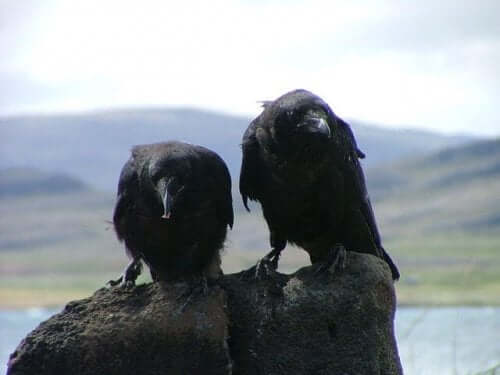The Use of Tools in Animals

The use of tools is something that we traditionally associate with human beings. However, we’re now coming to realize more and more that the use of tools in animals is much more common than perhaps we first thought.
The more we research the animal kingdom, the more we see that the differences that separate humans and animals are nowhere near as large as we think. The use of tools is no exception to this, something which was first observed in chimpanzees.
The use of tools in animals – primates
When a young Jane Goodall was researching this species at the Gombe Stream National Park in Tanzania, she discovered chimpanzees using branches to ‘fish’ termites out of their nests.
This was just the beginning. Gradually, other examples of using tools would be discovered and even examples of tools being manufactured. For example, chimpanzees have also been observed removing leaves from branches in order to catch insects.
Primates are undoubtedly the animals that have been most observed using tools, particularly the great apes. Most of them are afraid of water, and researchers have observed them using branches to check the depth of rivers and lakes.
The use of stones to create makeshift mills or nutcrackers or the manufacture of sharp spears for hunting are just some other discoveries in primates, even if they might seem like something out of a science-fiction movie. Furthermore, they pass on all of these techniques to future generations and thus they become a genuine cultural phenomenon.
Other primates, such as crab-eating macaques, use plant fibers, feathers, or even human hair to clean their teeth, using the strands as dental floss.
When a young Jane Goodall was researching this species at the Gombe National Park in Tanzania, she discovered chimpanzees using branches to ‘fish’ termites out of their nests.
Cetacea
Given that they lack hands, we know very little about the potential for cetaceans to use tools. This is particularly true for very intelligent species such as dolphins. However, this hasn’t stopped them from trying.

For example, dolphins in Shark Bay, Western Australia use sponges to protect their snouts. They use the sponge as a bumper to avoid injury by rocks or coral when searching for food on the seabed.
In fact, dolphins have been observed teaching each other this behavior. This ability has allowed the United States Army to use them to clear mines. It makes you wonder what they might be able to do if they had limbs like us.
Other mammals that use tools
Elephants are some of the most intelligent animals there are, and they also use tools. For example, they have been observed using branches to bat away insects or scratch themselves, and they’re able to modify these branches for the specific task.
Elephants also dig holes to access groundwater to drink, but incredibly, will chew tree bark, roll it into a ball, and use to stop up the hole so that the water doesn’t evaporate and they can return for a drink later. They have also been seen launching objects to destroy electric fences.
One fascinating use of tools in animals is that of the sea otter. These creatures will lie on their backs in the water and rest a mollusk on their belly. They will then take a rock in their hands and use it to break open the shell.
The use of tools has also been observed at a simpler level in bears, badgers, and even mongooses.
Elephants will chew tree bark, roll it into a ball, and use to stop up a water hole. This way, the water doesn’t evaporate and they can return for a drink later.
Do birds use tools?
It turns out that even some birds are capable of using tools. These include crows, jays, and rooks, who have all been observed leaving nuts on the road for cars to break.

This behavior is reminiscent of another bird, a scavenger called the bearded vulture. Once they find a carcass, they’ll drop bones on the floor so that they break, allowing them to consume the marrow.
Some authors consider that the ability to make a nest is a great example of the use of tools in animals.
Another great example is the Woodpecker Finch. This Galapagos bird uses small cactus spikes to pry its prey out of tree holes. Some parrot species also break shells with stones so that they can get calcium. As you can see, there’s plenty of evidence that we’re not so different from other animals.
